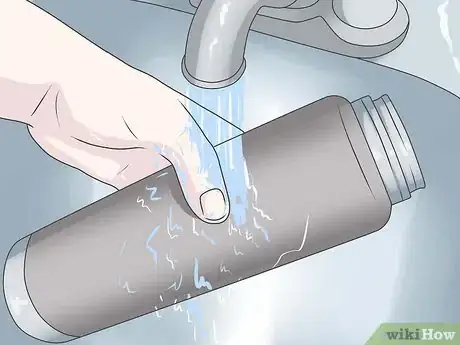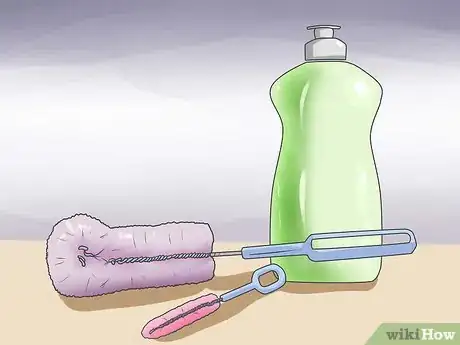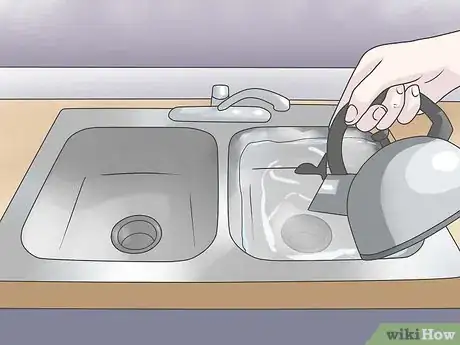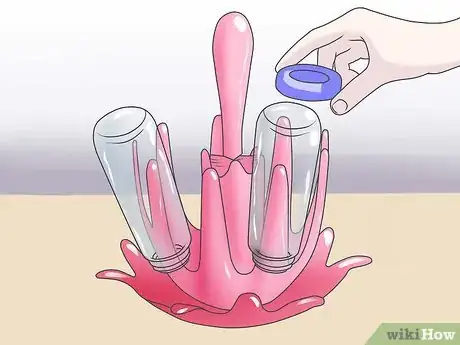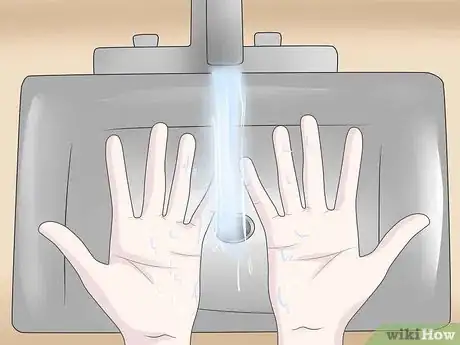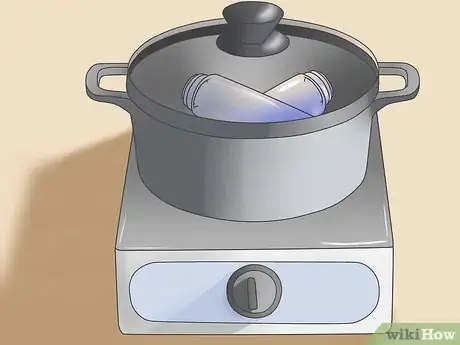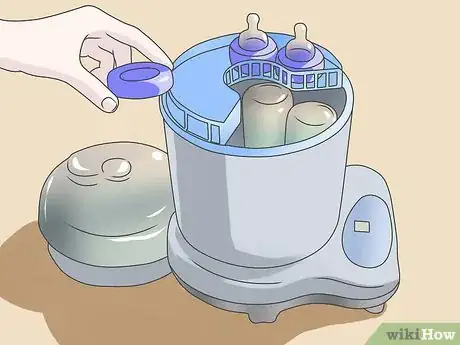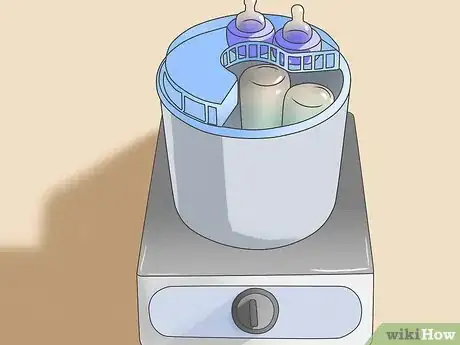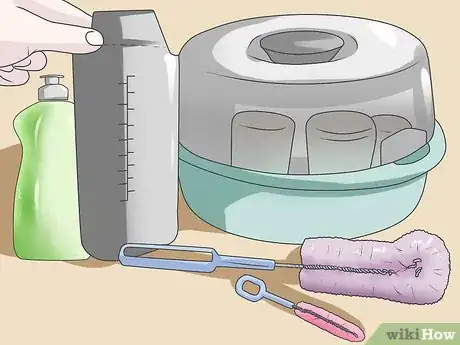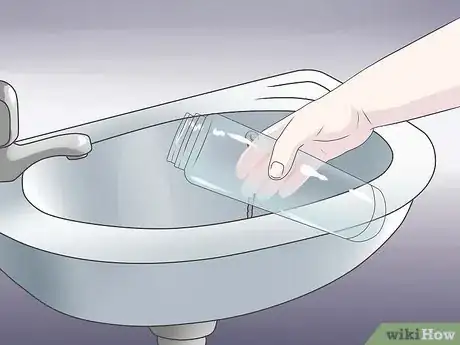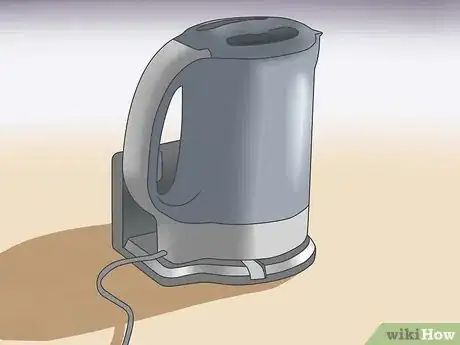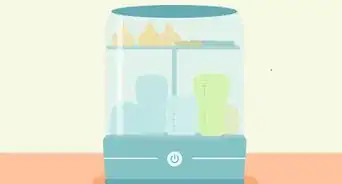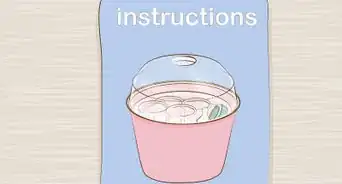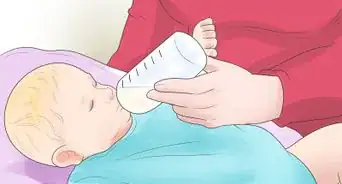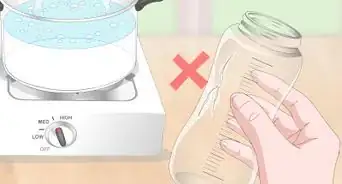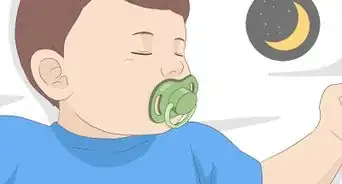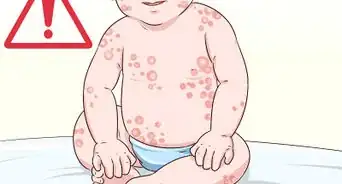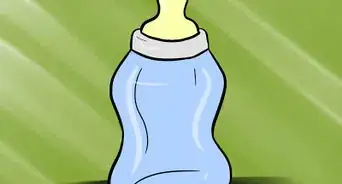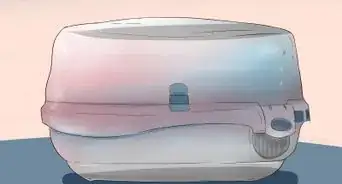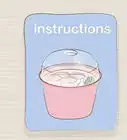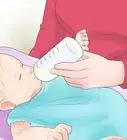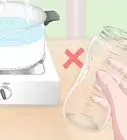This article was co-authored by Rebecca Nguyen, MA. Rebecca Nguyen is a Certified Lactation Consultant and Childbirth Educator. She runs Family Picnic in Chicago, Illinois with her mother Sue Gottschall, where they teach new parents about childbirth, breastfeeding and child development and education. Rebecca taught preschool through 3rd grade for 10 years, and she received her Master’s Degree in Early Childhood Education from the University of Illinois in 2003.
wikiHow marks an article as reader-approved once it receives enough positive feedback. In this case, 100% of readers who voted found the article helpful, earning it our reader-approved status.
This article has been viewed 217,997 times.
Washing baby bottles can seem like an endless chore, so it may become tempting to skip proper cleaning. However, the proper cleaning of baby bottles is extremely important, as babies' immune systems have not fully developed, making them much more susceptible to getting sick from bacteria in dirty bottles. To ensure your baby stays safe and healthy, start with Step 1 below for detailed instructions on how to properly wash baby bottles.
Steps
Cleaning Bottles
-
1Rinse the baby bottles directly after use. As soon as you have finished feeding your baby, give the bottle a quick rinse out in the sink.
- You can wash the bottle more thoroughly later on when you have time, but this will prevent any old milk or dirt from accumulating in the bottle.
- Try to use hot water when rinsing out the bottle, as this will clean more effectively.[1]
-
2Gather the right cleaning materials. When cleaning out baby bottles, it helps to use the right materials. Make sure you have:[2]
- A bottle brush to help you clean the bottom and sides of the bottle and a nipple brush to clean out the rubber nipple, which is prone to accumulating bacteria.
- Dishwashing liquid designed specifically for baby bottles. This is very gentle and non-toxic and will not leave a soapy residue on the bottles.
- If you are using plastic baby bottles, make sure that they are free from BPA (bisphenol A), an estrogen-mimicking chemical that was banned by the FDA in 2012.[3]
Advertisement -
3Rinse out the sink and fill with hot soapy water. Before you wash your bottles, it's a good idea to clean the sink you intend to use first, to remove any potential bacteria or chemicals.
- Use a sponge or scouring pad to scrub down the bottom and sides of the sink and around the plug using hot water. You can use a little baking soda as a natural disinfectant if necessary.
- Once the sink is clean and rinsed, fill it with hot water (as hot as your hands can comfortably handle) and dish soap.[4]
-
4Dismantle the bottle and wash each part separately. When cleaning baby bottles, it's necessary to take them apart and wash each part -- the bottle, the ring and the nipple -- separately.
-
5Alternatively, wash the bottles in the dishwasher. If your bottles are labelled dishwasher safe, you can go ahead and wash them in the dishwasher.[7]
- Stack the bottles upside-down on the top rack of the dishwasher, away from the heating element.
- You can buy special dishwasher-safe baskets for the nipples and rings in baby supply stores.
-
6Allow the bottles to dry thoroughly. After washing, rinse the bottle parts thoroughly in hot running water to remove any bubbles or soap residue.[8]
- Place the parts on a bottle drying rack (available at baby supply stores in a range of cute designs).
- Make sure the bottles are left to drain in a well-ventilated location to ensure that they dry thoroughly. Bottles that remain damp for too long can grow mold or fungus.
-
7Wash your hands before bottle feeding your baby. Once the bottles are dry, remember to wash your hands thoroughly with soap and warm water before handling the bottles or feeding your baby.
Sterilizing Bottles
-
1Understand that it's not necessary to sterilize bottles after each use. Although parents were once advised to sterilize bottles after every use, this is no longer deemed necessary.[9]
- According to The American Academy of Pediatrics, washing your bottle with hot, soapy water is enough to effectively clean it -- as long as the water is safe to drink.[10]
- However, it is still necessary to sterilize new bottles before their first use and to sterilize bottles that have been washed with well water after each use.
-
2Use a bottle sterilizer. When you need to sterilize your bottles, you can do so using an electric steam sterilizer or a microwave steam sterilizer.
- With both types of sterilizer, the bottles are immersed in steam at a temperature of 212 degrees F (or 100 degrees C), which kills off any bacteria.
- With the electric sterilizer, you add water, stack the bottles, rings and nipples (spaced well apart), cover with a lid, plug in and turn on. The sterilization process takes approximately 10 minutes.
- With the microwave sterilizer, the process is essentially the same. Once the bottles are in the sterilizer, place it in the microwave and heat on full power for 4 to 8 minutes, depending on the wattage of your microwave.
-
3Sterilize bottles in boiling water. The old fashioned way of sterilizing bottles simply involved boiling them in a pot of water.
- Bring a large pot of water to the boil, then add the bottle parts, cover with a lid and boil for at least 5 minutes.[11]
- This method is best for sterilizing glass baby bottles, but will work on plastic ones too (provided they don't contain BPA).
Cleaning Bottles While Traveling
-
1Be prepared. The best way to deal with bottle cleaning when travelling is to be prepared.[12]
- Carry a small bottle of dish soap and a bottle brush in a sealable plastic bag at all times.
- Use disposable bottle liners, so you only have to bring one bottle. The liners can be changed after each feed so the bottle only needs to be washed at night.
- If you're staying somewhere with a microwave, bring a portable microwave sterilizer with you when you travel.
-
2Wash the bottles in a hotel sink or public restroom. If you're prepared and have your dish soap and bottle brush with you, you can wash the bottles in any available sink.
- Just make sure to give the sink a rinse down first, to remove any obvious dirt.
- Once washed, place the bottle parts on a clean towel to dry.
-
3Sterilize using a travel kettle. If you've used a sink with water unsafe for drinking, you may need to sterilize bottles while traveling.
- As mentioned above, the easiest way to do this is with a portable microwave sterilizer, but if you don't have access to a microwave, you can make do with a travel kettle and a small pair of bottle tongs.
- Simply fill the kettle with water, plug it in and allow to boil. Pour the boiling water over the (washed) bottle parts in the sink. Use the tongs to remove the items from the sink and place them on a clean towel to dry.
References
- ↑ Rebecca Nguyen, MA. International Board Certified Lactation Consultant. Expert Interview. 10 June 2019.
- ↑ https://www.parents.com/baby/care/american-baby-how-tos/how-to-clean-baby-bottles/
- ↑ http://well.blogs.nytimes.com/2013/12/18/ask-well-how-to-clean-baby-bottles/?_php=true&_type=blogs&_r=0
- ↑ Rebecca Nguyen, MA. International Board Certified Lactation Consultant. Expert Interview. 10 June 2019.
- ↑ Rebecca Nguyen, MA. International Board Certified Lactation Consultant. Expert Interview. 10 June 2019.
- ↑ http://www.parents.com/baby/care/american-baby-how-tos/how-to-clean-baby-bottles/
- ↑ https://www.cdc.gov/healthywater/hygiene/healthychildcare/infantfeeding/cleansanitize.html
- ↑ https://www.cdc.gov/healthywater/hygiene/healthychildcare/infantfeeding/cleansanitize.html
- ↑ Rebecca Nguyen, MA. International Board Certified Lactation Consultant. Expert Interview. 10 June 2019.
About This Article
To wash baby bottles, start by taking them apart so you can wash all the individual pieces. If the bottles are dishwasher safe, you can go ahead and wash them in the dishwasher. Otherwise, soak the bottles in hot soapy water and scrub them with a bottle brush. You should also sterilize brand new baby bottles before using them. To sterilize a bottle, simply place it in a pot of boiling water, cover the pot, and let the bottle boil for 3 minutes. If you want to learn how to clean bottles while you're traveling, keep reading the article!
